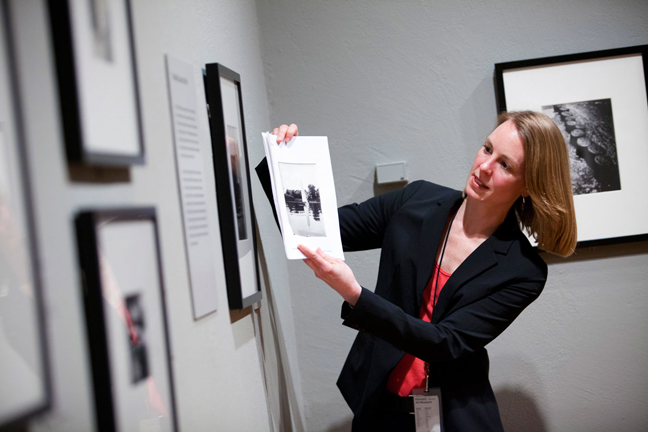With collections that span millennia and media and that come from many different cultures and parts of the world, the Harvard Art Museums are an extraordinary resource for Harvard University. Museums staff have long worked with faculty in the History of Art and Architecture (HAA) department to advance their course goals, and the museums’ renovation and expansion will significantly increase the capacity to deepen what’s happening in classrooms across campus. But syncing our vast collections with coursework is no small task. In addition to collaborating with art history faculty, the museums also work with faculty from a range of departments, such as music and organismic and evolutionary biology. This work requires curatorial expertise and a thorough knowledge of our collections—skills that Laura Muir brings to her new position as Research Curator for Academic and Public Programs.
In this role, Muir is managing curatorial exchanges with the campus community for the university galleries, conducting collections-based research projects, and overseeing activities that will take place in the Art Study Center. Although Muir is new to the Division of Academic and Public Programs (DAPP), she is no stranger to the museums: for 12 years she served as Assistant Curator in the Busch-Reisinger Museum, where she recently curated the groundbreaking exhibition Lyonel Feininger: Photographs, 1928–1939, which traveled to Berlin, Munich, and Los Angeles before coming to our galleries in Cambridge. She also authored the award-winning catalogue that accompanied the show. At the Busch-Reisinger, Muir worked closely with the museums’ collections, performing research, helping faculty with course-related exhibitions, and managing one of the museums’ former study rooms. These experiences make her a perfect fit for the Research Curator position.
“A vital part of our role as an academic art institution is making our collections accessible to the campus that we serve,” said Tom Lentz, Director of the Harvard Art Museums. “Our Art Study Center and university galleries provide tremendous opportunities for faculty and students to engage with original works of art. The curatorial perspective that Laura brings to this role will help our long-standing academic partners in the History of Art and Architecture department and faculty from across the university activate our collections in powerful and exciting ways.” Through conversations with professors and her fellow curators, Muir will help tailor how the museums’ collections are used in teaching and learning and will build on established relationships and courses that were developed through the years with faculty from HAA.
Yukio Lippit, Professor of History of Art and Architecture, is one of these faculty members. Using works from the superb collection of Japanese paintings that were recently gifted to the museums by Robert and Betsy Feinberg, Lippit is planning an installation in the museums’ University Teaching Gallery for both an undergraduate lecture course and a seminar for graduate students and advanced undergraduates. He is selecting paintings from Japan’s Edo period (1615–1868) that represent the ukiyo-e school (ukiyo means “floating world”). The rare works depict subject matter relating to urban entertainment centers, such as the kabuki theater and pleasure quarters. While on display in the University Teaching Gallery, these paintings will allow Lippit’s students to visually trace historical change and discover multiple cultural narratives.
For Lippit, the merits of using the museums’ university galleries are many. “They enable repeated viewing of the same material, which is crucial in art history classes,” said Lippit. “One-time viewings are special and catalytic of many things, but in order to help students develop their understanding of art and also to pursue research projects, it is helpful to be able to repeatedly return to the same artworks, so that this dialogic relationship of viewing, research, analysis—and more research—can evolve. This enables the kind of in-depth engagement with art that is possible in a university museum setting.”
The objects-based teaching and learning that Lippit and his HAA colleagues have been doing with the museums’ collections showcase how faculty members at Harvard can access the museums’ resources through their own disciplinary lens. As Research Curator for Academic and Public Programs, Laura Muir will be at the faculty’s side. “The Harvard Art Museums’ collections are deep and our resources are extensive,” Muir notes. “Sharing the knowledge that’s stored in original works of art is at the heart of what curators do, and I am thrilled to continue this work in collaboration with all Harvard faculty.”
Faculty and students won’t be the only ones benefiting from this collaboration when the museums open this fall—the museums’ university galleries and Art Study Center will also be open to the public.



